technical specifications FIAT PUNTO 2020 Owner handbook (in English)
[x] Cancel search | Manufacturer: FIAT, Model Year: 2020, Model line: PUNTO, Model: FIAT PUNTO 2020Pages: 219, PDF Size: 9.82 MB
Page 118 of 219
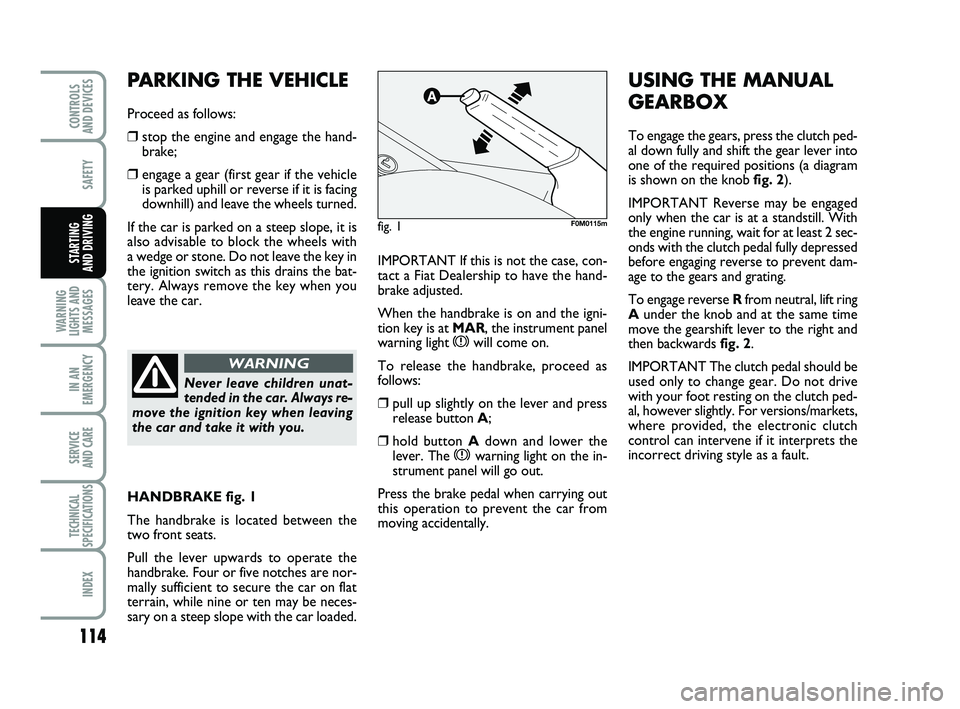
114
SAFETY
WARNING
LIGHTS AND MESSAGES
IN AN
EMERGENCY
SERVICE
AND CARE
TECHNICAL
SPECIFICATIONS
INDEX
CONTROLS
AND DEVICES
STARTING
AND DRIVINGIMPORTANT If this is not the case, con-
tact a Fiat Dealership to have the hand-
brake adjusted.
When the handbrake is on and the igni-
tion key is at MAR, the instrument panel
warning light
xwill come on.
To release the handbrake, proceed as
follows:
❒pull up slightly on the lever and press
release button A;
❒hold button A down and lower the
lever. The xwarning light on the in-
strument panel will go out.
Press the brake pedal when carrying out
this operation to prevent the car from
moving accidentally.
PARKING THE VEHICLE
Proceed as follows:
❒stop the engine and engage the hand- brake;
❒engage a gear (first gear if the vehicleis parked uphill or reverse if it is facing
downhill) and leave the wheels turned.
If the car is parked on a steep slope, it is
also advisable to block the wheels with
a wedge or stone. Do not leave the key in
the ignition switch as this drains the bat-
tery. Always remove the key when you
leave the car.
Never leave children unat-
tended in the car. Always re-
move the ignition key when leaving
the car and take it with you.
WARNING
fig. 1F0M0115m
HANDBRAKE fig. 1
The handbrake is located between the
two front seats.
Pull the lever upwards to operate the
handbrake. Four or five notches are nor-
mally sufficient to secure the car on flat
terrain, while nine or ten may be neces-
sary on a steep slope with the car loaded.
USING THE MANUAL
GEARBOX
To engage the gears, press the clutch ped-
al down fully and shift the gear lever into
one of the required positions (a diagram
is shown on the knob fig. 2).
IMPORTANT Reverse may be engaged
only when the car is at a standstill. With
the engine running, wait for at least 2 sec-
onds with the clutch pedal fully depressed
before engaging reverse to prevent dam-
age to the gears and grating.
To engage reverse R from neutral, lift ring
A under the knob and at the same time
move the gearshift lever to the right and
then backwards fig. 2.
IMPORTANT The clutch pedal should be
used only to change gear. Do not drive
with your foot resting on the clutch ped-
al, however slightly. For versions/markets,
where provided, the electronic clutch
control can intervene if it interprets the
incorrect driving style as a fault.
111-120 PUNTO POP 1ed EN 24/09/13 14.29 Pagina 114
Page 119 of 219
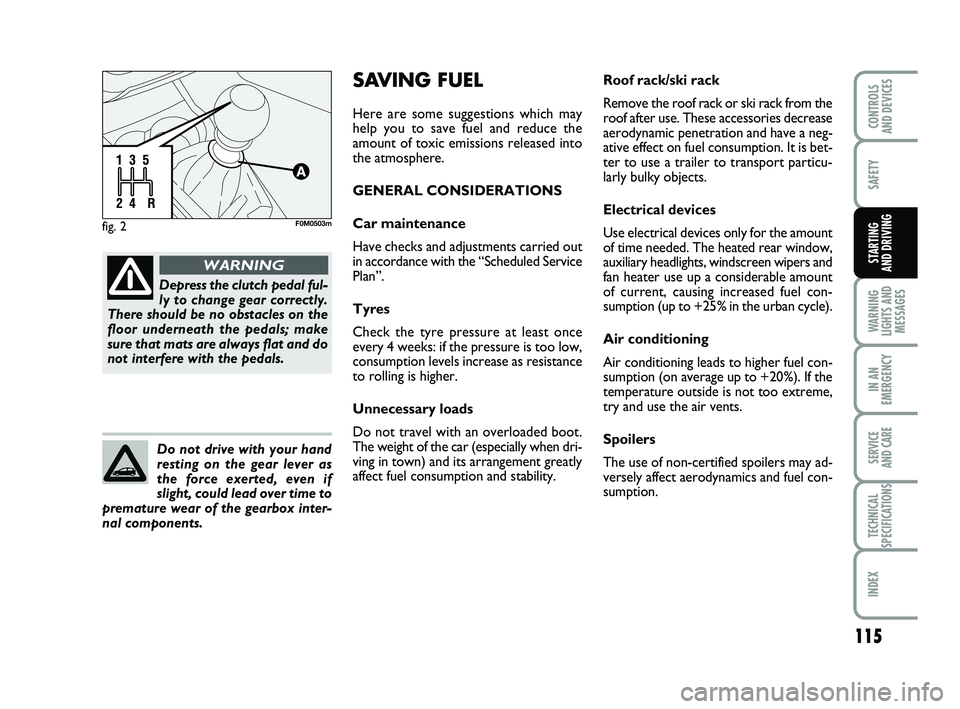
115
SAFETY
WARNING
LIGHTS AND MESSAGES
IN AN
EMERGENCY
SERVICE
AND CARE
TECHNICAL
SPECIFICATIONS
INDEX
CONTROLS
AND DEVICES
STARTING
AND DRIVING
fig. 2F0M0503m
Depress the clutch pedal ful-
ly to change gear correctly.
There should be no obstacles on the
floor underneath the pedals; make
sure that mats are always flat and do
not interfere with the pedals.
WARNING
Do not drive with your hand
resting on the gear lever as
the force exerted, even if
slight, could lead over time to
premature wear of the gearbox inter-
nal components.
Roof rack/ski rack
Remove the roof rack or ski rack from the
roof after use. These accessories decrease
aerodynamic penetration and have a neg-
ative effect on fuel consumption. It is bet-
ter to use a trailer to transport particu-
larly bulky objects.
Electrical devices
Use electrical devices only for the amount
of time needed. The heated rear window,
auxiliary headlights, windscreen wipers and
fan heater use up a considerable amount
of current, causing increased fuel con-
sumption (up to +25% in the urban cycle).
Air conditioning
Air conditioning leads to higher fuel con-
sumption (on average up to +20%). If the
temperature outside is not too extreme,
try and use the air vents.
Spoilers
The use of non-certified spoilers may ad-
versely affect aerodynamics and fuel con-
sumption.SAVING FUEL
Here are some suggestions which may
help you to save fuel and reduce the
amount of toxic emissions released into
the atmosphere.
GENERAL CONSIDERATIONS
Car maintenance
Have checks and adjustments carried out
in accordance with the “Scheduled Service
Plan”.
Tyres
Check the tyre pressure at least once
every 4 weeks: if the pressure is too low,
consumption levels increase as resistance
to rolling is higher.
Unnecessary loads
Do not travel with an overloaded boot.
The weight of the car (especially when dri-
ving in town) and its arrangement greatly
affect fuel consumption and stability.
111-120 PUNTO POP 1ed EN 24/09/13 14.29 Pagina 115
Page 120 of 219
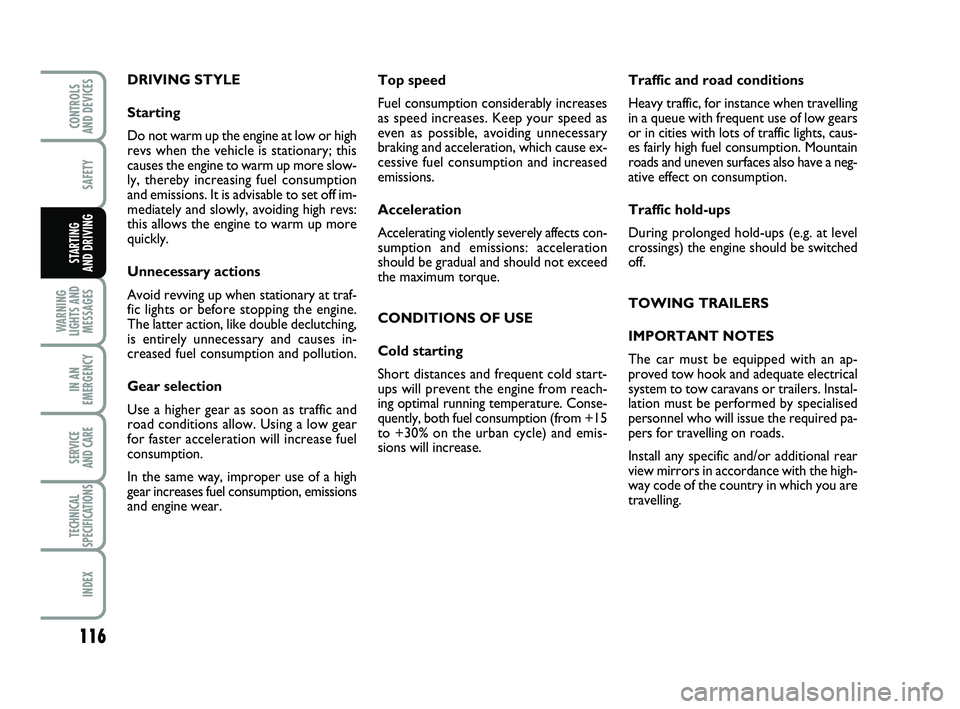
116
SAFETY
WARNING
LIGHTS AND MESSAGES
IN AN
EMERGENCY
SERVICE
AND CARE
TECHNICAL
SPECIFICATIONS
INDEX
CONTROLS
AND DEVICES
STARTING
AND DRIVING
DRIVING STYLE
Starting
Do not warm up the engine at low or high
revs when the vehicle is stationary; this
causes the engine to warm up more slow-
ly, thereby increasing fuel consumption
and emissions. It is advisable to set off im-
mediately and slowly, avoiding high revs:
this allows the engine to warm up more
quickly.
Unnecessary actions
Avoid revving up when stationary at traf-
fic lights or before stopping the engine.
The latter action, like double declutching,
is entirely unnecessary and causes in-
creased fuel consumption and pollution.
Gear selection
Use a higher gear as soon as traffic and
road conditions allow. Using a low gear
for faster acceleration will increase fuel
consumption.
In the same way, improper use of a high
gear increases fuel consumption, emissions
and engine wear. Traffic and road conditions
Heavy traffic, for instance when travelling
in a queue with frequent use of low gears
or in cities with lots of traffic lights, caus-
es fairly high fuel consumption. Mountain
roads and uneven surfaces also have a neg-
ative effect on consumption.
Traffic hold-ups
During prolonged hold-ups (e.g. at level
crossings) the engine should be switched
off.
TOWING TRAILERS
IMPORTANT NOTES
The car must be equipped with an ap-
proved tow hook and adequate electrical
system to tow caravans or trailers. Instal-
lation must be performed by specialised
personnel who will issue the required pa-
pers for travelling on roads.
Install any specific and/or additional rear
view mirrors in accordance with the high-
way code of the country in which you are
travelling.
Top speed
Fuel consumption considerably increases
as speed increases. Keep your speed as
even as possible, avoiding unnecessary
braking and acceleration, which cause ex-
cessive fuel consumption and increased
emissions.
Acceleration
Accelerating violently severely affects con-
sumption and emissions: acceleration
should be gradual and should not exceed
the maximum torque.
CONDITIONS OF USE
Cold starting
Short distances and frequent cold start-
ups will prevent the engine from reach-
ing optimal running temperature. Conse-
quently, both fuel consumption (from +15
to +30% on the urban cycle) and emis-
sions will increase.
111-120 PUNTO POP 1ed EN 24/09/13 14.29 Pagina 116
Page 121 of 219
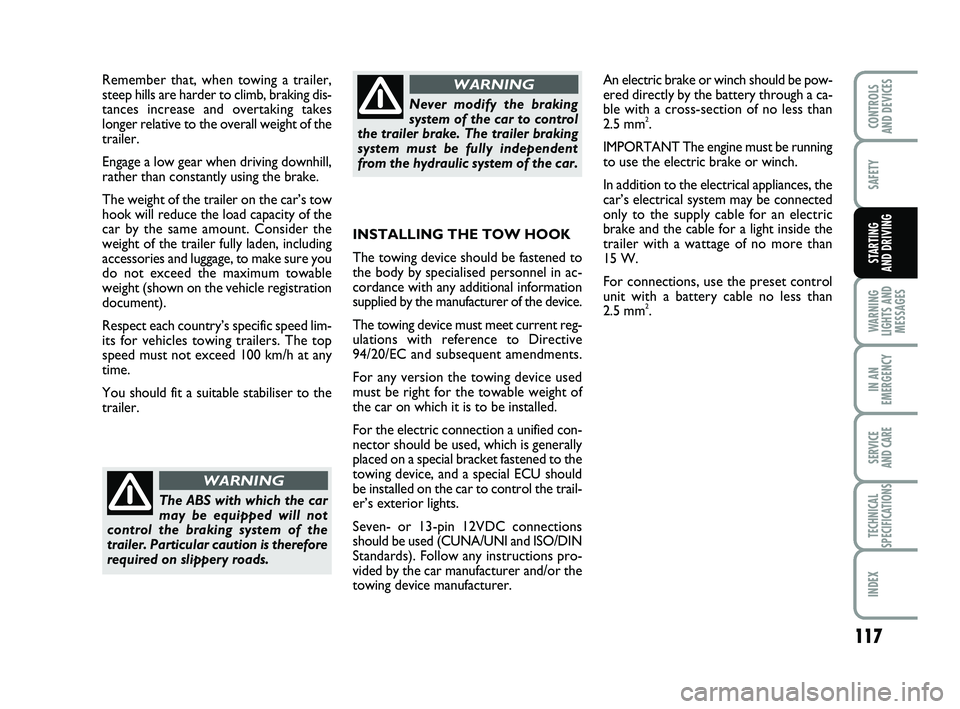
117
SAFETY
WARNING
LIGHTS AND MESSAGES
IN AN
EMERGENCY
SERVICE
AND CARE
TECHNICAL
SPECIFICATIONS
INDEX
CONTROLS
AND DEVICES
STARTING
AND DRIVING
Remember that, when towing a trailer,
steep hills are harder to climb, braking dis-
tances increase and overtaking takes
longer relative to the overall weight of the
trailer.
Engage a low gear when driving downhill,
rather than constantly using the brake.
The weight of the trailer on the car’s tow
hook will reduce the load capacity of the
car by the same amount. Consider the
weight of the trailer fully laden, including
accessories and luggage, to make sure you
do not exceed the maximum towable
weight (shown on the vehicle registration
document).
Respect each country’s specific speed lim-
its for vehicles towing trailers. The top
speed must not exceed 100 km/h at any
time.
You should fit a suitable stabiliser to the
trailer.
The ABS with which the car
may be equipped will not
control the braking system of the
trailer. Particular caution is therefore
required on slippery roads.
WARNING
Never modify the braking
system of the car to control
the trailer brake. The trailer braking
system must be fully independent
from the hydraulic system of the car.
WARNING
INSTALLING THE TOW HOOK
The towing device should be fastened to
the body by specialised personnel in ac-
cordance with any additional information
supplied by the manufacturer of the device.
The towing device must meet current reg-
ulations with reference to Directive
94/20/EC and subsequent amendments.
For any version the towing device used
must be right for the towable weight of
the car on which it is to be installed.
For the electric connection a unified con-
nector should be used, which is generally
placed on a special bracket fastened to the
towing device, and a special ECU should
be installed on the car to control the trail-
er’s exterior lights.
Seven- or 13-pin 12VDC connections
should be used (CUNA/UNI and ISO/DIN
Standards). Follow any instructions pro-
vided by the car manufacturer and/or the
towing device manufacturer. An electric brake or winch should be pow-
ered directly by the battery through a ca-
ble with a cross-section of no less than
2.5 mm
2.
IMPORTANT The engine must be running
to use the electric brake or winch.
In addition to the electrical appliances, the
car’s electrical system may be connected
only to the supply cable for an electric
brake and the cable for a light inside the
trailer with a wattage of no more than
15 W.
For connections, use the preset control
unit with a battery cable no less than
2.5 mm
2.
111-120 PUNTO POP 1ed EN 24/09/13 14.29 Pagina 117
Page 122 of 219
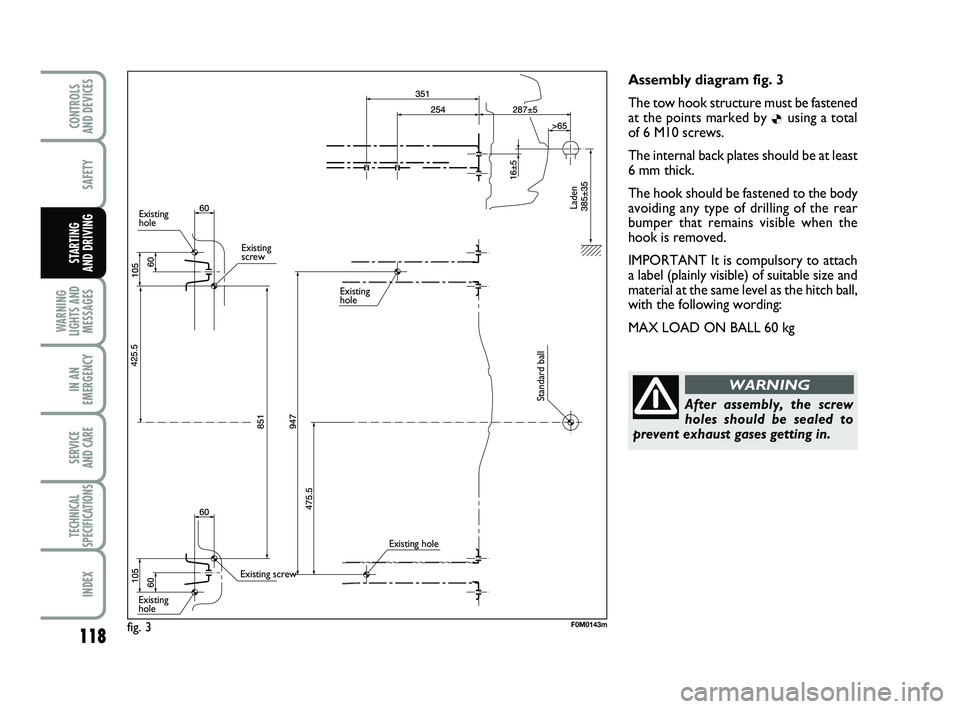
118
SAFETY
WARNING
LIGHTS AND MESSAGES
IN AN
EMERGENCY
SERVICE
AND CARE
TECHNICAL
SPECIFICATIONS
INDEX
CONTROLS
AND DEVICES
STARTING
AND DRIVING
Assembly diagram fig. 3
The tow hook structure must be fastened
at the points marked by
Øusing a total
of 6 M10 screws.
The internal back plates should be at least
6 mm thick.
The hook should be fastened to the body
avoiding any type of drilling of the rear
bumper that remains visible when the
hook is removed.
IMPORTANT It is compulsory to attach
a label (plainly visible) of suitable size and
material at the same level as the hitch ball,
with the following wording:
MAX LOAD ON BALL 60 kg
After assembly, the screw
holes should be sealed to
prevent exhaust gases getting in.
WARNING
fig. 3F0M0143m
Existing
hole
Existing
screw
Existing screw
Existing
hole Existing
hole
Existing hole
Standard ball Laden
111-120 PUNTO POP 1ed EN 24/09/13 14.29 Pagina 118
Page 123 of 219
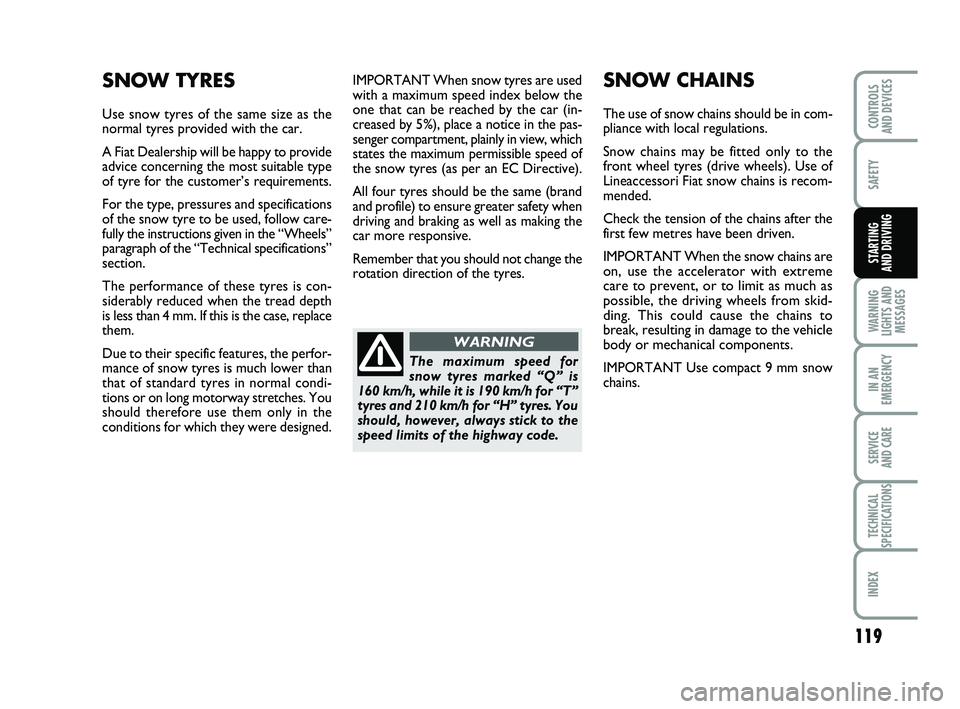
119
SAFETY
WARNING
LIGHTS AND MESSAGES
IN AN
EMERGENCY
SERVICE
AND CARE
TECHNICAL
SPECIFICATIONS
INDEX
CONTROLS
AND DEVICES
STARTING
AND DRIVING
IMPORTANT When snow tyres are used
with a maximum speed index below the
one that can be reached by the car (in-
creased by 5%), place a notice in the pas-
senger compartment, plainly in view, which
states the maximum permissible speed of
the snow tyres (as per an EC Directive).
All four tyres should be the same (brand
and profile) to ensure greater safety when
driving and braking as well as making the
car more responsive.
Remember that you should not change the
rotation direction of the tyres.SNOW CHAINS
The use of snow chains should be in com-
pliance with local regulations.
Snow chains may be fitted only to the
front wheel tyres (drive wheels). Use of
Lineaccessori Fiat snow chains is recom-
mended.
Check the tension of the chains after the
first few metres have been driven.
IMPORTANT When the snow chains are
on, use the accelerator with extreme
care to prevent, or to limit as much as
possible, the driving wheels from skid-
ding. This could cause the chains to
break, resulting in damage to the vehicle
body or mechanical components.
IMPORTANT Use compact 9 mm snow
chains.
SNOW TYRES
Use snow tyres of the same size as the
normal tyres provided with the car.
A Fiat Dealership will be happy to provide
advice concerning the most suitable type
of tyre for the customer’s requirements.
For the type, pressures and specifications
of the snow tyre to be used, follow care-
fully the instructions given in the “Wheels”
paragraph of the “Technical specifications”
section.
The performance of these tyres is con-
siderably reduced when the tread depth
is less than 4 mm. If this is the case, replace
them.
Due to their specific features, the perfor-
mance of snow tyres is much lower than
that of standard tyres in normal condi-
tions or on long motorway stretches. You
should therefore use them only in the
conditions for which they were designed.
The maximum speed for
snow tyres marked “Q” is
160 km/h, while it is 190 km/h for “T”
tyres and 210 km/h for “H” tyres. You
should, however, always stick to the
speed limits of the highway code.
WARNING
111-120 PUNTO POP 1ed EN 24/09/13 14.29 Pagina 119
Page 124 of 219
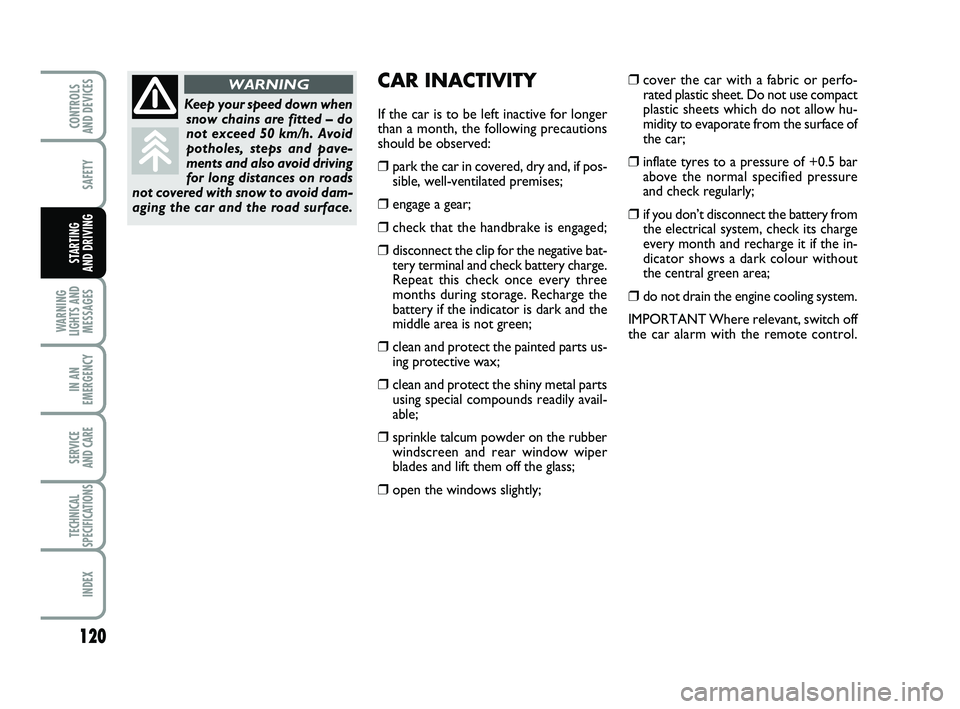
120
SAFETY
WARNING
LIGHTS AND MESSAGES
IN AN
EMERGENCY
SERVICE
AND CARE
TECHNICAL
SPECIFICATIONS
INDEX
CONTROLS
AND DEVICES
STARTING
AND DRIVING
CAR INACTIVITY
If the car is to be left inactive for longer
than a month, the following precautions
should be observed:
❒park the car in covered, dry and, if pos- sible, well-ventilated premises;
❒engage a gear;
❒check that the handbrake is engaged;
❒disconnect the clip for the negative bat-tery terminal and check battery charge.
Repeat this check once every three
months during storage. Recharge the
battery if the indicator is dark and the
middle area is not green;
❒clean and protect the painted parts us-ing protective wax;
❒clean and protect the shiny metal partsusing special compounds readily avail-
able;
❒sprinkle talcum powder on the rubberwindscreen and rear window wiper
blades and lift them off the glass;
❒open the windows slightly;
❒cover the car with a fabric or perfo-rated plastic sheet. Do not use compact
plastic sheets which do not allow hu-
midity to evaporate from the surface of
the car;
❒inflate tyres to a pressure of +0.5 barabove the normal specified pressure
and check regularly;
❒if you don’t disconnect the battery fromthe electrical system, check its charge
every month and recharge it if the in-
dicator shows a dark colour without
the central green area;
❒do not drain the engine cooling system.
IMPORTANT Where relevant, switch off
the car alarm with the remote control.
Keep your speed down when snow chains are fitted – do
not exceed 50 km/h. Avoid
potholes, steps and pave-
ments and also avoid driving
for long distances on roads
not covered with snow to avoid dam-
aging the car and the road surface.
WARNING
111-120 PUNTO POP 1ed EN 24/09/13 14.29 Pagina 120
Page 125 of 219
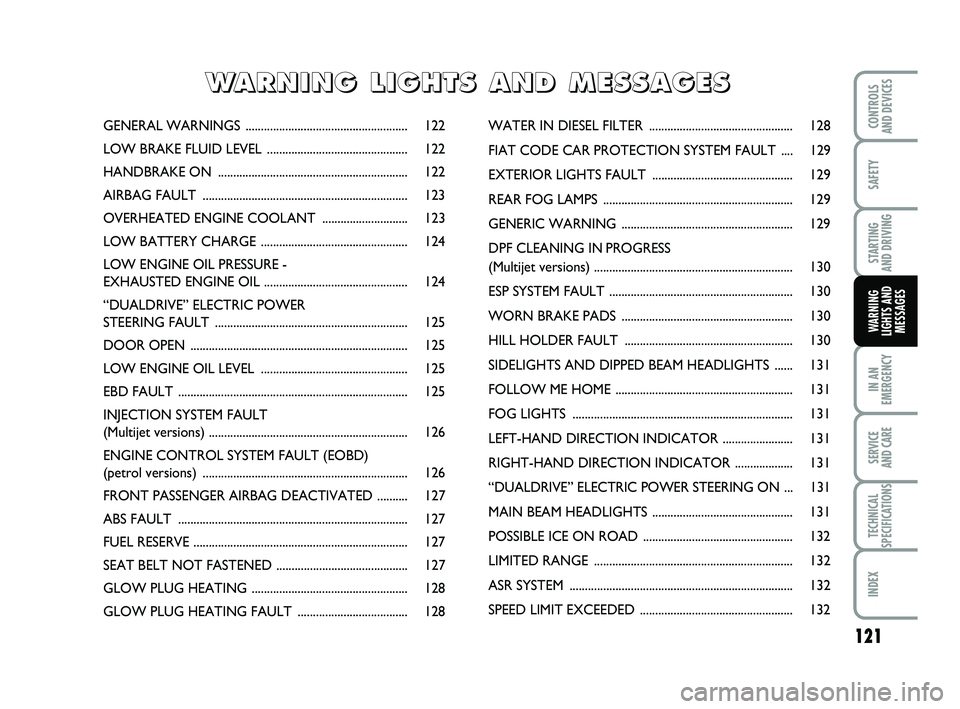
121
SAFETY
STARTING
AND DRIVING
IN AN
EMERGENCY
SERVICE
AND CARE
TECHNICAL
SPECIFICATIONS
INDEX
CONTROLS
AND DEVICES
WARNING
LIGHTS AND MESSAGES
GENERAL WARNINGS ..................................................... 122
LOW BRAKE FLUID LEVEL .............................................. 122
HANDBRAKE ON .............................................................. 122
AIRBAG FAULT ................................................................... 123
OVERHEATED ENGINE COOLANT ............................ 123
LOW BATTERY CHARGE ................................................ 124
LOW ENGINE OIL PRESSURE -
EXHAUSTED ENGINE OIL ............................................... 124
“DUALDRIVE” ELECTRIC POWER
STEERING FAU LT ............................................................... 125
DOOR OPEN .......................................................................\
125
LOW ENGINE OIL LEVEL ................................................ 125
EBD FAULT .......................................................................\
.... 125
INJECTION SYSTEM FAULT
(Multijet vers ions) ................................................................. 126
ENGINE CONTROL SYSTEM FAULT (EOBD)
(petrol vers ions) ................................................................... 126
FRONT PASSENGER AIR BAG DEACTIVATED .......... 127
ABS FAULT .......................................................................\
.... 127
FUEL RESERVE ...................................................................... 127
SEAT BELT NOT FASTENED ........................................... 127
GLOW PLUG H EATING ................................................... 128
GLOW PLUG HEATIN G FAULT .................................... 128 WATER IN DIES
EL FILTER ............................................... 128
FIAT CODE CAR PROTECTION SYSTEM FAULT .... 129
EXTERIOR LIG HTS FAULT .............................................. 129
REAR FOG LAMPS .............................................................. 129
GENERIC WAR NING ........................................................ 129
DPF CLEANING IN PROGRESS
(Multijet versions) ................................................................. 130
ESP SYSTEM FAU LT ............................................................ 130
WORN BRAKE PADS ........................................................ 130
HILL HOLDER FAULT ....................................................... 130
SIDELIGHTS AND DIPP ED BEAM HEADLIGHTS ...... 131
FOLLOW ME HO ME .......................................................... 131
FOG LIGHTS ........................................................................\
131
LEFT-HAND DIRECTION INDICAT OR ....................... 131
RIGHT-HAND DIRECT ION INDICATOR ................... 131
“DUALDRIVE” ELECTRIC POWER STEERING ON ... 131
MAIN BEAM HEADLIGHTS .............................................. 131
POSSIBLE ICE ON ROAD .................................................
132
LIMITED RANGE ................................................................. 132
ASR SYSTEM ......................................................................\
... 132
SPEED LIMIT EXCEEDED .................................................. 132
W
W
A
A
R
R
N
N
I
I
N
N
G
G
L
L
I
I
G
G
H
H
T
T
S
S
A
A
N
N
D
D
M
M
E
E
S
S
S
S
A
A
G
G
E
E
S
S
121-132 PUNTO POP 1ed EN 29/08/13 15.03 Pagina 121
Page 126 of 219
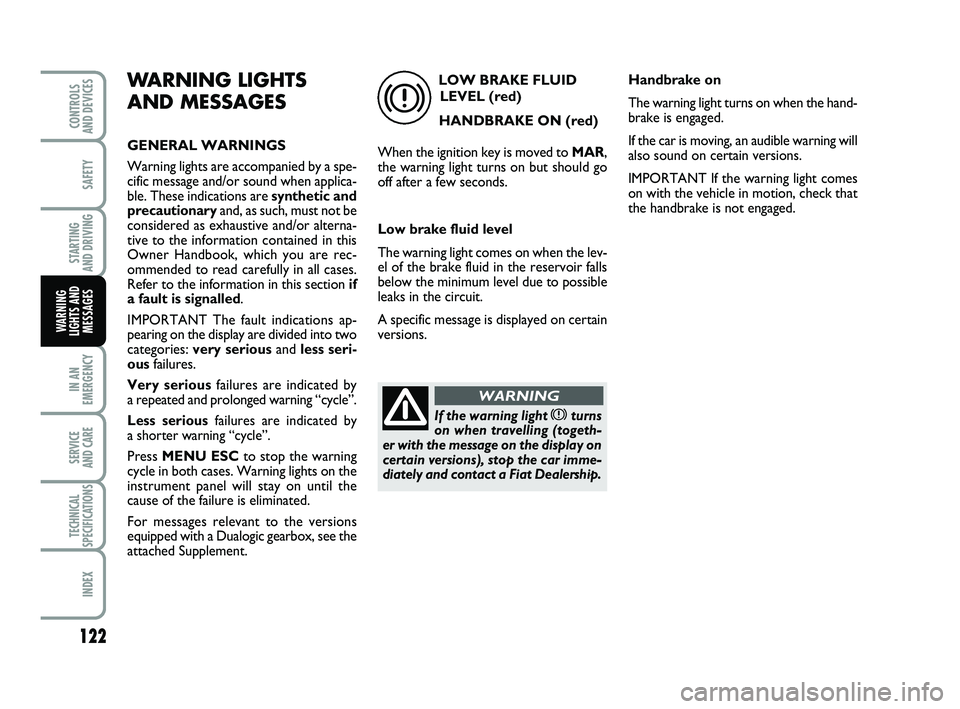
122
SAFETY
STARTING
AND DRIVING
IN AN
EMERGENCY
SERVICE
AND CARE
TECHNICAL
SPECIFICATIONS
INDEX
CONTROLS
AND DEVICES
WARNING
LIGHTS AND MESSAGES
WARNING LIGHTS
AND MESSAGES
GENERAL WARNINGS
Warning lights are accompanied by a spe-
cific message and/or sound when applica-
ble. These indications are synthetic and
precautionary and, as such, must not be
considered as exhaustive and/or alterna-
tive to the information contained in this
Owner Handbook, which you are rec-
ommended to read carefully in all cases.
Refer to the information in this section if
a fault is signalled .
IMPORTANT The fault indications ap-
pearing on the display are divided into two
categories: very serious and less seri-
ous failures.
Very serious failures are indicated by
a repeated and prolonged warning “cycle”.
Less serious failures are indicated by
a shorter warning “cycle”.
Press MENU ESC to stop the warning
cycle in both cases. Warning lights on the
instrument panel will stay on until the
cause of the failure is eliminated.
For messages relevant to the versions
equipped with a Dualogic gearbox, see the
attached Supplement. LOW BRAKE FLUID
LEVEL (red)
HANDBRAKE ON (red)
When the ignition key is moved to MAR,
the warning light turns on but should go
off after a few seconds.
Low brake fluid level
The warning light comes on when the lev-
el of the brake fluid in the reservoir falls
below the minimum level due to possible
leaks in the circuit.
A specific message is displayed on certain
versions.
x
If the warning light xturns
on when travelling (togeth-
er with the message on the display on
certain versions), stop the car imme-
diately and contact a Fiat Dealership.
WARNING
Handbrake on
The warning light turns on when the hand-
brake is engaged.
If the car is moving, an audible warning will
also sound on certain versions.
IMPORTANT If the warning light comes
on with the vehicle in motion, check that
the handbrake is not engaged.
121-132 PUNTO POP 1ed EN 29/08/13 15.03 Pagina 122
Page 127 of 219
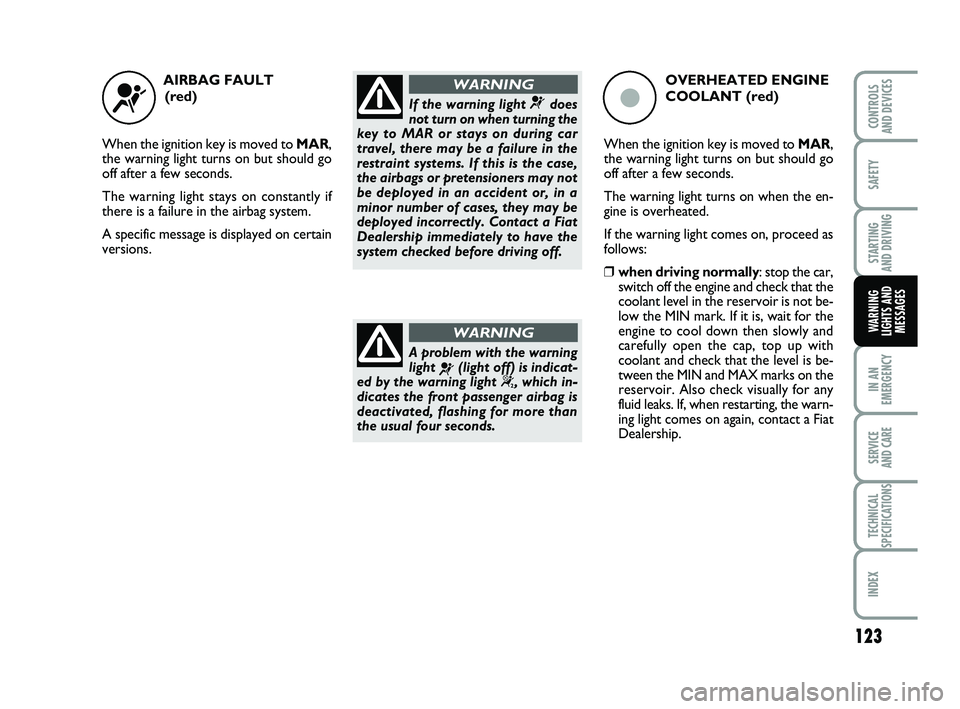
123
SAFETY
STARTING
AND DRIVING
IN AN
EMERGENCY
SERVICE
AND CARE
TECHNICAL
SPECIFICATIONS
INDEX
CONTROLS
AND DEVICES
WARNING
LIGHTS AND MESSAGES
AIRBAG FAULT
(red)
When the ignition key is moved to MAR,
the warning light turns on but should go
off after a few seconds.
The warning light stays on constantly if
there is a failure in the airbag system.
A specific message is displayed on certain
versions.
¬If the warning light ¬does
not turn on when turning the
key to MAR or stays on during car
travel, there may be a failure in the
restraint systems. If this is the case,
the airbags or pretensioners may not
be deployed in an accident or, in a
minor number of cases, they may be
deployed incorrectly. Contact a Fiat
Dealership immediately to have the
system checked before driving off.
WARNING
A problem with the warning
light
¬(light off) is indicat-
ed by the warning light
“, which in-
dicates the front passenger airbag is
deactivated, flashing for more than
the usual four seconds.
WARNING
OVERHEATED ENGINE
COOLANT (red)
When the ignition key is moved to MAR,
the warning light turns on but should go
off after a few seconds.
The warning light turns on when the en-
gine is overheated.
If the warning light comes on, proceed as
follows:
❒ when driving normally: stop the car,
switch off the engine and check that the
coolant level in the reservoir is not be-
low the MIN mark. If it is, wait for the
engine to cool down then slowly and
carefully open the cap, top up with
coolant and check that the level is be-
tween the MIN and MAX marks on the
reservoir. Also check visually for any
fluid leaks. If, when restarting, the warn-
ing light comes on again, contact a Fiat
Dealership.
ç
121-132 PUNTO POP 1ed EN 29/08/13 15.03 Pagina 123